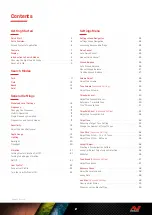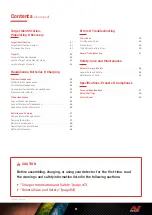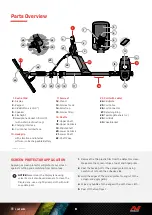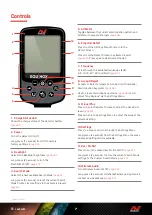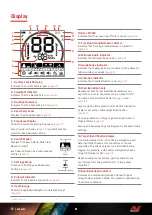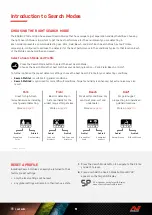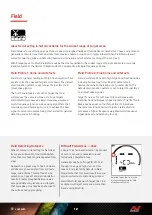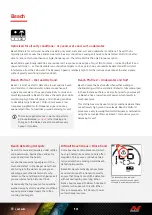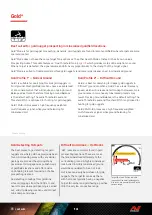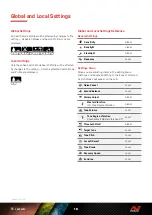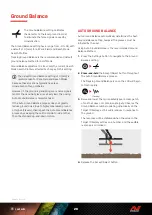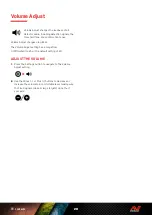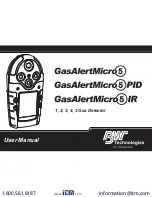
13
Optimised for all salty conditions – dry sand, wet sand, surf, underwater.
Beach Mode is for salt water beaches including dry sand, wet sand, surf and underwater conditions� The salt that is
typically present causes the sand and water to be very conductive, causing salt noise to be detected� Multi-IQ is better
able to reduce this noise than any single-frequency can� Therefore Multi is the only Frequency option�
Beach Mode specifically identifies any residual salt response and assigns a Target ID of 0 (zero) — indicating that it's an
unwanted target — so that desirable low conductive targets such as gold chains can readily be detected with minimal
interference from the salt-water� The Recovery Speed is relatively high to further reduce unwanted salt-water signals,
without greatly sacrificing detection depth�
Beach Profile 1 — Wet and Dry Sand
Beach 1 is most useful for detecting in wet and dry beach
sand and also in shallow water where conductive salt
signals are prevalent� It has good sensitivity to coins and
small/large jewellery� Beach 1 reduces the salt signal, while
maintaining high transmit power, and still being sensitive
to desirable targets� Beach 1 Multi-IQ processes a low
frequency weighted multi-frequency signal, and uses
special algorithms to maximise ground balancing for salt�
To maximise performance in wet sand, perform
a Ground Balance
after making any
changes to the Noise Cancel channel, Recovery
Speed or Iron Bias�
Beach Profile 2 — Underwater and Surf
Beach 2 gives the best results when either wading or
shallow diving, with the coil and/or detector fully submerged�
In these instances, there is a very strong salt signal present,
so Beach 2 has a lower transmit power, which results in
much less noise�
This Profile may also be useful in dry conditions where there
are extremely high ground noise levels� Beach 2 Multi-IQ
processes a very low weighted multi-frequency combination,
using the same algorithms as Beach 1 to maximise ground
balancing for salt�
Beach Detecting Hotspots
Search for coins and jewellery under jetties
and board-walks, beside steps and entry
ways to and from the beach�
Locate the areas where people swim the
most and detect in the deeper water there�
Venturing into the water can give you an
advantage over other detectorists who
remain on the sand� Research shipwrecks if
you are interested in historical finds�
Occasionally, the top layers of sand will be
washed away by stormy weather conditions,
exposing some deeper layers that often
contain good targets�
Difficult Beach Areas — Black Sand
Some beaches contain black sand, which
has high natural iron content and is often
magnetic� This causes continuous false
ferrous detections, making normal beach
detecting impossible�
Beach Mode automatically senses black
sand and reduces the transmit power to
ensure that targets can still be detected
without overloading occurring� When
black sand is sensed, the Beach Overload
Indicator will appear on the LCD� When
this icon disappears, full transmit power
automatically resumes�
Beach
The Beach Overload Indicator
appears when the transmit signal
strength is automatically reduced�
Summary of Contents for EQUINOX 700
Page 1: ...Instruction Manual...
Page 4: ...4 CONTENTS Getting Started...
Page 10: ...10 CONTENTS Search Modes...
Page 15: ...15 CONTENTS General Settings...
Page 23: ...23 CONTENTS Settings Menu...
Page 40: ...40 CONTENTS Target Identification Pinpointing Recovery...
Page 44: ...44 CONTENTS Headphones Batteries Charging...
Page 49: ...49 CONTENTS Errors Troubleshooting...
Page 53: ...53 CONTENTS Safety Care and Maintenance...
Page 56: ...56 CONTENTS Specifications Presets Compliance...


